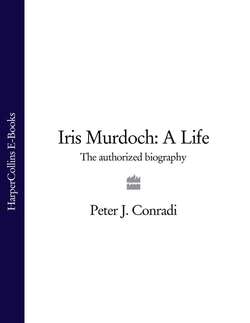Читать книгу Iris Murdoch: A Life: The Authorized Biography - Peter Conradi J. - Страница 36
9
ОглавлениеIris began her first romance, by correspondence, around 1937. When a letter came to tell of his death in 1970, she noted, ‘James is dead. First event of my adult life. Such a good man. And a good influence (on me, then),’ and wrote to his widow that he had been a ‘great awakener’. She gives no surname, but her Belfast cousins remember James Henderson Scott, who would facetiously identify himself as ‘Scott of Belfast’, born in 1913, and a good friend of cousin Cleaver.69 Scott finished his dentistry studies at Queen’s in 1937, medicine in 1942. Born into Methodism, he converted to Catholicism, was gifted and literary, and an enthusiast for that earlier convert Cardinal Newman. When he later became Professor of Dental Anatomy at Queen’s, he gave his inaugural lecture in blank verse.
Cleaver suggested that clever, bookish, ‘romantic’ James, who wrote and loved poetry, write to Cleaver’s highly intelligent, bookish cousin Iris, who also loved and wrote poetry. Both were Irish and loved Ireland. A correspondence started – ‘an elusive something drew [them] together’. Both had a feeling for Virgil’s ‘tears of things’, something sad and deep that belonged to ‘the very structure of the universe’ – though Iris’s apprehension was then more political, James’s religious. He fell for Iris – at least the dream-Iris he encountered in her imaginative, responsive letters – and then for the being he first met, his journals suggest, at the Peter Pan statue in Kensington Gardens just after noon on Saturday, 2 April 1938. ‘Something snapped’ inside him, he noted a year later, ‘which has never been repaired’. A romantic interest on Iris’s side did not survive this meeting, and she was able slowly to get James to accept this. ‘I want and I need your friendship over and above even that of the girl I marry,’ James noted. They sailed to Belfast on the Duke of Lancaster together on 5 April 1939, and spent time with Iris’s cousins and other friends. Iris and James climbed the tower of Queen’s University, tying a friend’s pyjamas to the flagpost. She witnessed her first operation at the Royal Victoria Hospital, James noting that she ‘would have made a wonderful medical student’, and had a fierce quarrel about Christianity and Communism. Friendship survived: Iris was good at this feat. She was later famous for a complicated private life in which she found it hard to disencumber herself of any of her many admirers. James then fell in unrequited love with cousin Sybil, and married Olive Marron in 1945.
Summer Irish holidays belong elsewhere in her story. Glimpses of London holidays are given by Margaret Orpen: she and Iris visited each other. Once they were to give a joint lecture to the school Architecture Club, for which they visited London’s Wren churches. On another occasion they went together to the Caledonian market in Islington, where Iris bought a necklace for sixpence. On Wednesday, 28 September 1938, after both had left school, Orpen and Iris found themselves standing in the gods at Covent Garden – they could not afford seats – watching a ballet, probably the de Basil company. It was exceptionally hot and stuffy. It was also the eve of Chamberlain and Hitler’s Munich agreement, the most critical moment of that ‘strange year full of anxiety and fear’.70 The letter Iris wrote Orpen afterwards ended with, ‘If we should meet again, why then we’ll smile,’ from Julius Caesar, a quotation that would resonate with deeper meaning six years later.
*‘Each for all, all for God.’
*Regulations posted in the entrance hall began: ‘1. Stockings must always be worn with Wellingtons for all walks. 2. During term time girls must never wear mufti unless they are in their own rooms. Mufti must never be worn in Bristol. 3. No girl is to bring talcum powder back to school …’ See Katherine Frank, Indira: The Life of Indira Gandhi (London, 2001), p. 117.
*e.g. 12 December 1934: ‘Pleasant lesson with I. Murdoch – asked her what she wanted to do next year – vague, but wants to go on with Greek.’ After Miss Bird had left the school in July 1937 and was settled in Cambridge, about to marry Maurice Howard, she noted, ‘H.C. [Higher Certificate]. Iris didn’t get distinction in Latin, though she did in English. So she hasn’t got a State Scholarship’ – no mention of a Greek result, though in those days students normally offered three main subjects and a subsidiary.
*( Indira Gandhi commented that ‘despite a terribly anti-Fascist and pacifist’ atmosphere, ‘imperialism seems to be inherent in the bones of the girls’ at Badminton, ‘… [though] they hate to hear you say so’. Frank, Indira, p.119.
† ‘What slim youngster (soaked in perfumes) is hugging you now, Pyrrha, on a bed of roses?’ (David West’s translation). Iris’s translation: ‘What graceful boy in fragrant odours steeped,/'Mid crimson roses in a cavern dim,/Worships your smile …’
≠ S.I. Hsiung’s old Chinese play had been translated into English in 1935.
